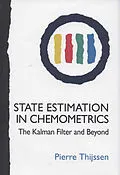Blends together state estimation and chemometrics for the application of advanced data-processing techniques
Provides short reviews on the history of state estimation and chemometrics, together with examples of the applications described
Dr Pierre Cornelis Thijssen studied chemistry at the Radboud University in the Netherlands, obtaining his Masters Degree in 1978. He then moved to the University of Amsterdam, where he graduated in 1986 with a Ph.D based on his thesis entitled 'State Estimation in Chemometrics' which is the basis of this book. Since then, Dr Thijssen has worked for various companies as a laboratory manager and chemometrician.
Autorentext
Dr. Pierre Cornelis Thijssen studied chemistry at the Radboud University Nijmegen in the Netherlands, obtaining his Master's Degree in 1978. He then moved to the University of Amsterdam in the Netherlands, where he graduated in 1986 with a PhD based on his thesis entitled "State Estimation in Chemometrics, which is the basis of this book. Since then, Dr. Thijssen has worked for various companies as a laboratory manager and chemometrician.
Leseprobe
1 Introduction
Publisher Summary
This chapter highlights the short reviews on the history of state estimation and chemometrics. From the viewpoint of system theory, state estimation applied to chemical analysis evolves a modular framework, which permits the development of simple intelligent analyzers. State estimation is concerned with the extraction of noise from measurements about some quantities that are essential to a system. A state is a minimal set of values sufficient to describe the behavior of a system. Three types of estimation problems are of interest: (1) filtering recovers the required information using the measurements up to the current point; (2) prediction is concerned with extrapolation into the future; and (3) smoothing investigates interpolation back in the past. Chemical analysis is referred to as the qualitative and/or quantitative determination of unknown constituents in samples. The analytical chemistry is devoted to the use and development of methods to enable chemical analysis. The instrumental stage introduces a great variety of novelties based on chemical or physical effects, which are transformed into an electrical signal. The measurement is performed by means of a recorder, voltmeter or oscilloscope.
Short reviews on the history of state estimation and chemometrics are given. From the viewpoint of system theory state estimation applied to chemical analysis evolves a modular framework, which permits the development of simple intelligent analyzers.
1.1 HistoryThe development of data processing techniques can be reviewed briefly in a historical perspective. At the beginning of the 19-th century Gauss (1809) developed the method of least squares and employed it in a simple orbit measurement system. During the next hundred years several others made contributions to the field of estimation. A breakthrough came when Fisher (1910), working with probability density functions, reinvented the approach of the maximum likelihood. Much of this work has been employed thereafter in the broad area of statistics. A major change of viewpoint occurred when Kolmogorov (1941) and Wiener (1942) operated on random processes in the frequency domain. This approach describes the estimation problem in term of correlation functions and the filter impulse response. It was limited to stationary processes and ensures only optimal estimates in the steady state regime. Over the next twenty years, this work was extended in an often-cumbersome way to include nonstationary and multiple sensor systems. In the early sixties of the previous century Kalman and others (1960) advanced estimation with the concept of the state space model in the time domain and set the foundation of modern state estimation.
State estimation is concerned with the extraction of noise from measurements about some quantities that are essential to a system. A state is a minimal set of values sufficient to describe the behaviour of a system. Three types of estimation problems are of interest: filtering recovers the required information using the measurements up to the current point; prediction is concerned with extrapolation into the future; and smoothing investigates interpolation back in the past. The Kalman filter is probably the most common estimation technique used in practice. Here, prediction and filtering are combined for an optimal performance of the estimation procedure. The approach is based on the online or recursive, rather than the batch processing of the measurements. It is ideally suited for computer implementation in automated systems and meets a broad application range: from ship navigation; image enhancement; process control; satellite orbit tracking; aircraft autopilot; earthquake forecasting to water resource planning.
The present book governs particularly applications of state estimation in the field of chemometrics. A lot of
Inhalt
- Dedication
- ABOUT OUR AUTHOR
- Chapter 1: Introduction
- Publisher Summary
- 1.1 History
- 1.2 Chemometrics
- 1.3 System view
- Chapter 2: Classical estimation
- Publisher Summary
- 2.1 Linear model
- 2.2 Least squares
- 2.3 Curve fitting
- 2.4 Recursive approach
- 2.5 Examples
- Chapter 3: State estimation
- Publisher Summary
- 3.1 State space model
- 3.2 Intermezzo
- 3.3 Prediction
- 3.4 Filtering
- 3.5 Kalman filter
- 3.6 Smoothing
- 3.7 Examples
- Chapter 4: Statistics
- Publisher Summary
- 4.1 Verification
- 4.2 Evaluation
- 4.3 Selection
- 4.4 Normality
- 4.5 Example
- Chapter 5: Nonlinear estimation
- Publisher Summary
- 5.1 Nonlinear state space model
- 5.2 Extended Kalman filter
- 5.3 Iterated extended Kalman filter
- 5.4 Iterated linearized filter-smoother
- 5.5 Nonlinear smoothing
- 5.6 Examples
- Chapter 6: The multicomponent system
- Publisher Summary
- 6.1 Multicomponent analysis
- 6.2 Stochastic drift
- 6.3 Examples
- Chapter 7: The calibration system
- Publisher Summary
- 7.1 Linear calibration
- 7.2 Nonlinear calibration
- 7.3 Examples
- Chapter 8: The titration system
- Publisher Summary
- 8.1 Discrete titration
- 8.2 Continuous titration
- 8.3 Nonlinear model
- 8.4 Examples
- Chapter 9: Miscellaneous
- Publisher Summary
- 9.1 Multiple modeling
- 9.2 Principal components
- 9.3 Examples
- Appendix
- Bibliography
- Index
